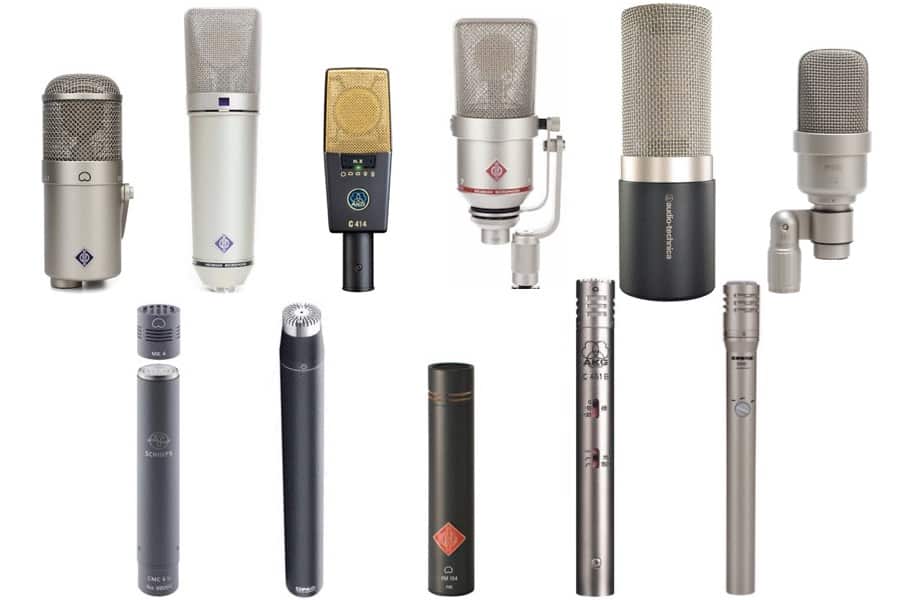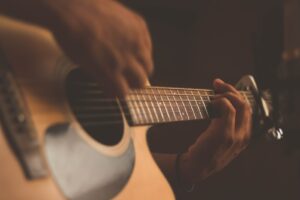Condenser microphones are renowned for their delicate capture of subtleties and high-frequency details, making them ideal for recording acoustic instruments, vocals, and electric guitars.
On the other hand, some guitarists favour dynamic microphones due to their capacity for handling high sound pressure levels and producing a warmer, distorted tone.
Remember that distance from the speaker cabinet greatly affects the sound quality produced when selecting microphone placement.
Placing it closer will produce brighter and more detailed audio capture while positioning it farther away creates a more ambient ambience.
When recording guitar, musicians must consider which microphone and placement works best for them according to personal preferences and the sound they want in their recordings.
Experimenting with different microphones and positioning techniques is key to finding the combination that produces your desired tone.
Utilising a Condenser Microphone When Recording Guitar
Condenser microphones are ideal for recording instruments with high-frequency sounds, such as guitars.
However, when recording acoustic guitars, the best microphone choice depends on your playing style.
Condenser microphones are preferred since they capture finer frequency ranges, creating an expansive, lush sound.
Condenser microphones typically provide an effective frequency range from 20 Hz to 20 kHz, making them ideal for recording delicate guitar tones.
Condenser microphones boast lightweight internal components contributing to their superior sound quality, as they are sensitive and responsive when recording subtle audio changes.
Condenser microphones capture all high-frequency sounds produced by guitars, providing detailed recordings even for professional guitarists looking to produce professional-level recordings.
Optimising Condenser Microphone Placement for Guitar Recording
When recording guitars, the placement of a condenser microphone is critical.
Different methods and theories are often employed when miking up guitar amps for recording purposes.
However, proper microphone placement is critical for accurately capturing a guitar sound. Avoid placing the condenser microphone too close to the amplifier’s speaker to avoid signal saturation.
When recording an amplified guitar with a condenser microphone, the distance between them should be carefully considered so as not to capture too much or too little of its sound.
When using this type of setup, be mindful that high-frequency sounds may be affected by where the microphone is positioned about other sources in the signal.
For bright and sharp tones, point directly at the centre of the amp’s speaker cone; conversely, angling towards its outer edge reduces brightness while amplifying mid and bass frequencies for a warmer sound.
What Are The Benefits Of Utilising A Condenser Microphone?
Condenser microphones are widely regarded as the premier choice for recording electric guitars due to their capacity for capturing subtle tonal differences.
Condenser microphones offer detailed and accurate recordings of guitar playing that cannot be captured with other types of microphones.
Condenser microphones are distinguished by their cardioid polar pattern, which looks like a heart and picks up sound primarily from the front while rejecting sound from the sides and rear.
Condenser microphones are renowned for their high sensitivity and wide frequency response range, making them ideal for capturing an acoustic guitar’s rich, detailed sound. They can pick up on subtle nuances other microphones may miss, providing a more accurate representation of the instrument than ever before.
Condenser microphones have exceptional sensitivity and a wide frequency response range, allowing them to capture the subtle nuances and richness of the instrument’s sound in greater detail.
How Do You Set Up The Microphone On the Guitar?
Proper placement of microphones is crucial when recording acoustic guitars or classical instruments to capture their authentic sound.
The XY technique ensures that the microphone is equidistant from the instrument, resulting in a more balanced and accurate representation of its sound.
Similarly, proper microphone placement is crucial in achieving the desired tone when recording electric guitars.
Placing a condenser microphone at the right edge of the speaker cone can produce a bright and open tone while moving it away can create a more ambient sound.
Factors such as the type of microphone, its position, and distance from the instrument all affect the outcome.
Place the condenser microphone at the right edge of the speaker cone to capture high-frequency sounds from a guitar amp and create an open, bright tone.
Additionally, two microphones should be placed at a 90-degree angle from one another for an expansive image.
Doing so helps capture audio accurately with excellent detail reproduction.
Who You Should Use a Condenser Microphone?
Condenser microphones are renowned for their versatility and are one of the best microphones in recording studios for various instruments.
Due to their sensitive response and lightweight internal components, condenser microphones can easily capture even subtle vocal performances or acoustic instruments.
However, condenser microphones can also record electric guitars and other instruments if placed close enough to the amplifier speaker to avoid saturation.
Their wider frequency range and ability to capture finer details make them indispensable in recording studios.
Though more delicate than their dynamic counterparts, their sonic sensitivity remains unsurpassed.
Condenser microphones boast high sensitivity, precisely capturing sound – especially at higher frequencies.
Can Electric Guitars Be Recorded Directly?
Recording an electric guitar presents numerous potential sound capture techniques, so selecting the correct technique is essential to getting your desired result.
Two primary methods are used when recording electric guitars: direct input and making an amplifier.
This can create a clear, uncluttered sound ideal for genres like jazz or blues.
Furthermore, it gives producers more control over their recorded audio by enabling them to add effects later during mixing.
Making up a guitar amp’s sound for more dynamic and versatile recording allows producers to experiment with different microphone placements and amplifier settings to craft unique sounds.
By positioning the microphone at different distances and angles from an amp, they can capture the tones produced by both instruments.
Why Select A Condenser Microphone For Audio Recording?
Condenser microphones are popular in recording studios due to their superior sound quality and versatility.
Their low-mass diaphragm design makes them highly responsive to sound waves, creating nuanced recordings with superb detail.
Due to their sensitivity, digital recorders are ideal for recording delicate vocals, acoustic guitars, cymbals and other high-frequency instruments.
Though sensitive enough to detect even subtle changes in sound quality, their sensitivity can also work against them by picking up unwanted background noise or handling noise if not managed properly.
Condenser microphones are known for their cardioid polar pattern, which is shaped like a heart and picks up sound primarily from the front while rejecting sound from the sides and rear.
This helps isolate guitar sound while minimizing interference from other sources, providing a clean recording with minimal hiss or pop.





